This edition comes after a break because I was busy working on good projects with good people. It’s fascinating how, once we know what we want, it starts to become real. Speaking of wants, Maslow’s hierarchy is a simple yet powerful sorting mechanism for human wants.
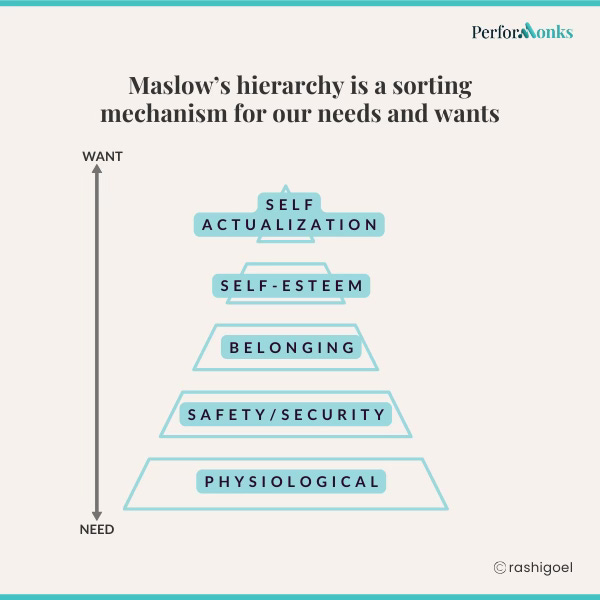
I call them lower-order to higher-order based on where they fall on the pyramid. (Don’t make the mistake of thinking that lower-order needs are less important. But we’ll get to that later.)
Maslow’s hierarchy can be a dependable thinking tool for Brand builders. Provided they understand its nuances. I hope this edition can help.
We cover:-
- Brand building 101 with Maslow’s hierarchy
- Nuances of Maslow’s hierarchy
- We cannot move upward until our basic needs are satisfied.
- Each category has an anchor need.
- Lower-order needs are not ‘less important’ or bereft of emotional richness.
- Know your ceiling.
Let’s go.
Brand building 101 with Maslow’s hierarchy
We hire products and brands for our jobs to be done.
If a Product gets your functional jobs done, then a Brand tackles your emotional jobs.
Here’s how it works.
Let’s say you have dry skin. Any simple moisturiser can get your functional job of moisturisation done.
But then you see this new cool moisturising technology – hyaluronic acid.
Before you can add to cart, your virtual shelf is inundated with more than 1,000 moisturisers (Amazon.in search results at the time of writing this).
They all contain hyaluronic acid.
They all promise hydration.
They all moisturise your skin.
A moisturiser from Company A catches your eye, “This moisturiser gives you plump, dewy skin, which makes you feel beautiful.”
While every other product shouts about molecules and moisture barriers, this one whispers your unspoken desires.
Repeated usage and the power of suggestion kick in, and you believe you look a little bit more beautiful each time you use this brand.
More importantly, you feel beautiful because you want to.
That’s why we say that a Brand is an invisible layer of meaning surrounding our products.
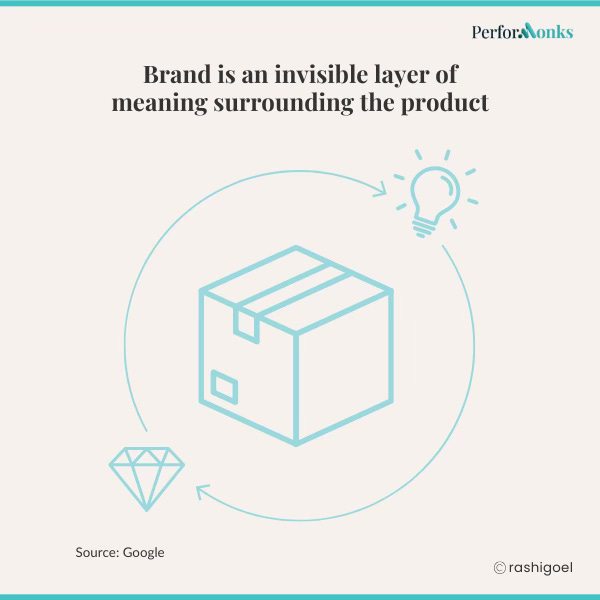
Company A just took the first step in its brand-building journey.
And you just took one step up Maslow’s hierarchy of needs.
Companies B, C and D could also climb the ladder to other higher-order emotions like confidence, freedom from worries or making you feel more flirtatious to differentiate.
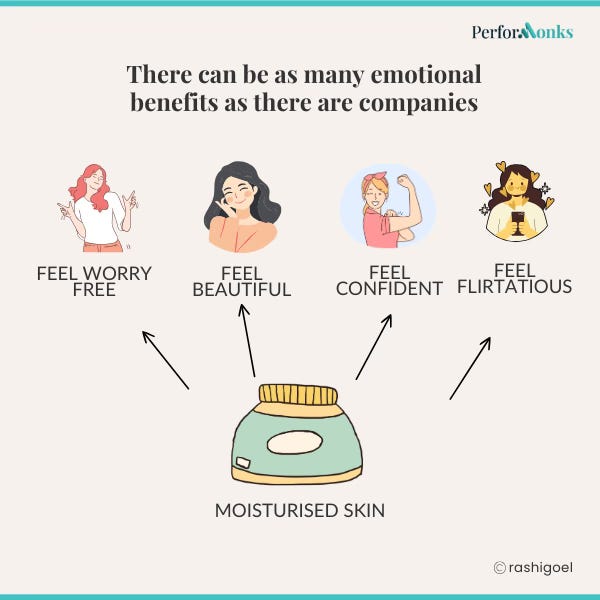
This is the simplest way to build brands.
From this point forward, things get complicated because humans and their emotions are complex and hidden. Often, we don’t even realize what emotions drive us.
To solve this puzzle, marketers must become psychologists who unearth nuggets of insights from all the noise.
That’s where Maslow’s hierarchy becomes useful. Here are six nuances not taught in B-Schools.
1. Lower-order needs are urgent and supersede higher-order needs at the moment of urgency.
When the sun beats down on us in a parched Sahara, we will gladly give away all the gold, fame, and houses we own for that last glass of water.
At that moment, we don’t quibble over the “brand” —Aquafina or Evian, Himalayan or Peruvian, Green or Blue—even unfiltered tap water will do.
Marketing implication: Physical availability at the point of demand becomes critical for products (brands) that satisfy physiological needs like food, water, shelter, and sex.
Example: even though Coca-Cola positions itself in the ‘belonging’ need state, as a thirst quencher, its mission is to be available within arm’s length of desire (thirst)
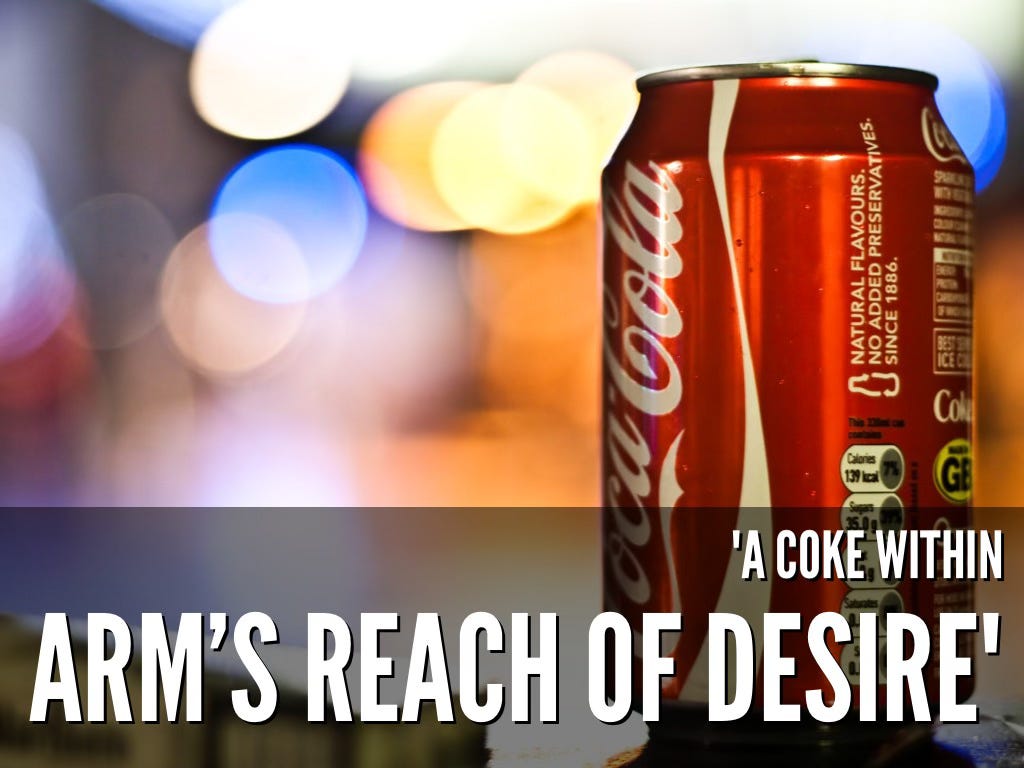
2. At its essence, each category was born to satisfy one anchor need.
If we forget everything about fashion, the anchor need for clothes is to protect our bodies. In the same way, the anchor need for medicines is to keep us safe. The anchor need for matchmaking is to make us feel loved.
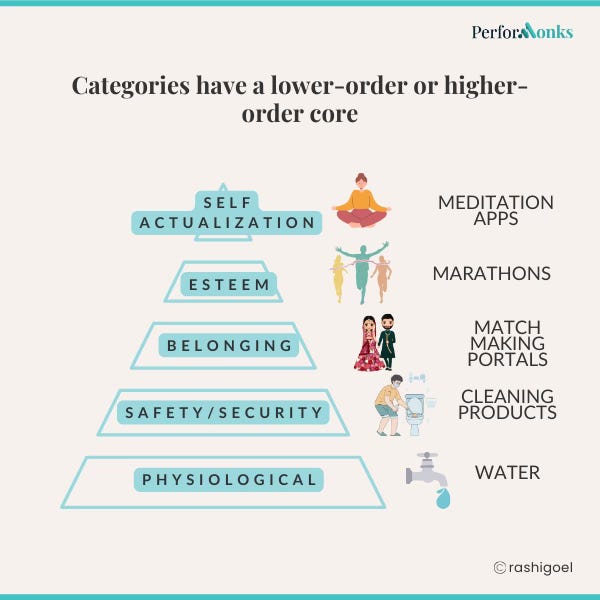
Marketing implication: Claims get complicated as competition grows and categories evolve.
- That’s when going back to basics can be a solid disruptive move, like Blue Bottle Coffee.
- Or more rarely, you can shatter your category anchor, like The Laundress.
Example: Blue Bottle Coffee differentiated itself from hundreds of other brands by doubling down on the fundamentals – just great coffee. They believe that coffee from beans roasted within 48 hours is the best-tasting coffee.
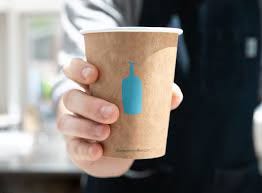
The Laundress shattered all the hierarchical rules of laundry and has positioned itself squarely on Self-Actualization.
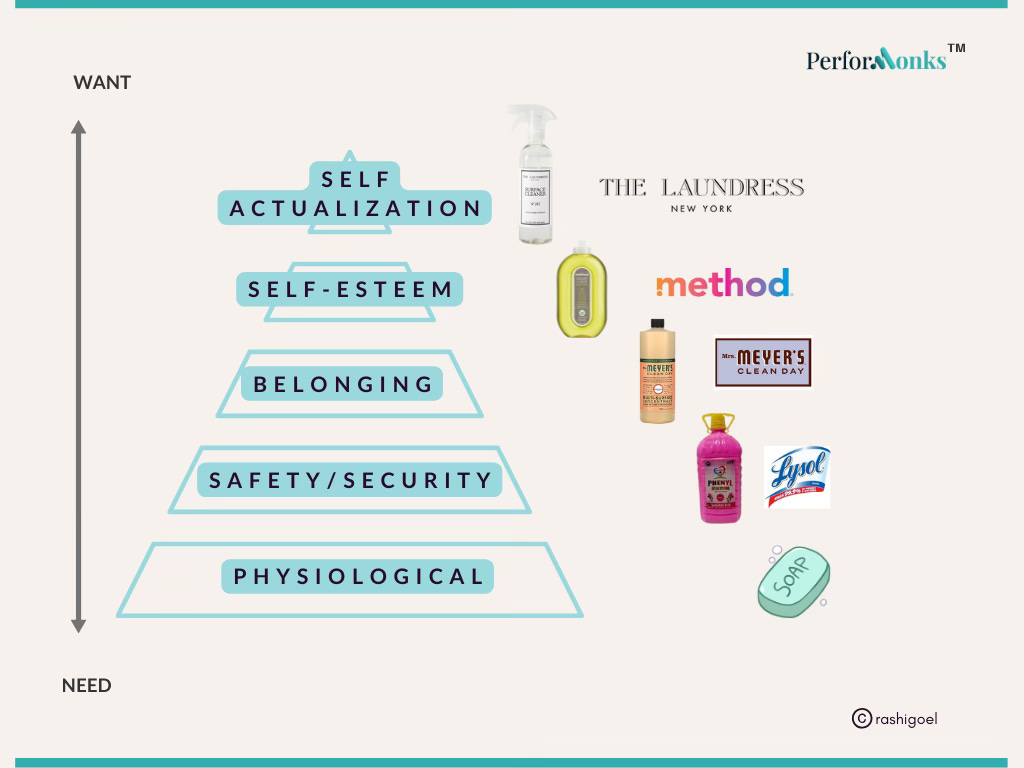
It has declared itself the laundry system and ‘dry cleaning alternative’ for luxury clothes.
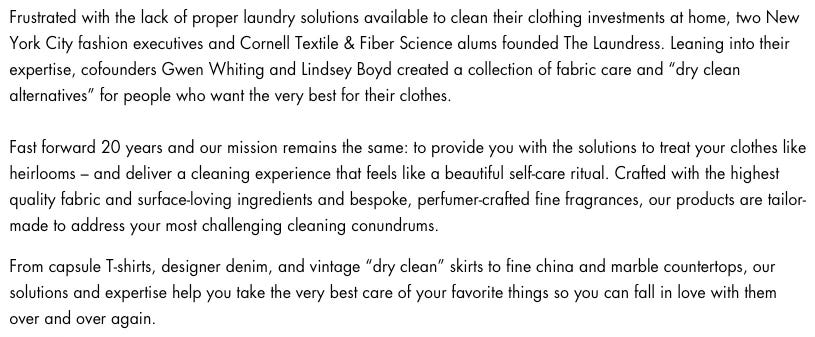
I love the genius of this brand and the unmet need it identified!
3. Categories anchored on lower-order needs are not ‘less important’ nor bereft of emotional benefits.
There is no denying the satisfaction a clean home or toilet provides. You feel pride when guests visit and your toilet sparkles. You also feel proud when your son wins a medal on sports day.
These are two different shades of pride.
Neither can substitute the other.
Neither is ‘superior’ to the other. ( We don’t start living like pigs if our kids do well in sports!)
Marketing implication: Look for emotions that surround the ‘mundane’.
Example: Surf/Omo transformed its fortunes by associating clean clothes with the freedom to let kids play and get dirty because when kids get messy, it means they’re learning and growing. ‘Dirt is Good”!”

Another great example is Febreze. At launch, Febreze promised the obvious functional benefit of odour control. But it flopped—until the marketing team realized that people couldn’t perceive bad odours in their own homes! So they repositioned Febreze as the last step in the home cleaning ritual to reassure themselves and to signal that their space was clean. Sales took off.
4. Brands must earn their right to climb Maslow’s ladder.
Unless a brand has positioned itself on a higher level from day 1, it will likely fail if it moves upwards from its anchor.
Marketing implication: A Primark cannot be a Gucci. But a Gucci is Gucci everywhere.
Example: Hellmann’s preaching an end to food waste out of the blue made eyes roll. But when Nike says, “Just Do It,” we believe it because they’ve built that altitude from day one. [Source]
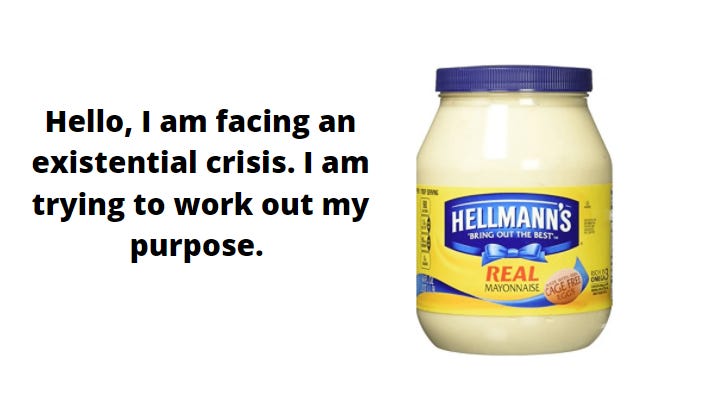
5. Conversely, once you’ve claimed higher ground, you automatically own the levels below.
Marketing implication: if you are positioned at a higher level, as long as your product delivers lower-order needs, consumers looking for lower-order benefits will also buy you.
Example: We saw how Coca-Cola can be a thirst quencher, even though it is positioned for the ‘belonging’ need state.
Here is another example. Gatorade targets athletes who play sports for personal excellence (self-actualization). Even athletes who play to win medals (esteem need), will drink Gatorade to recharge.
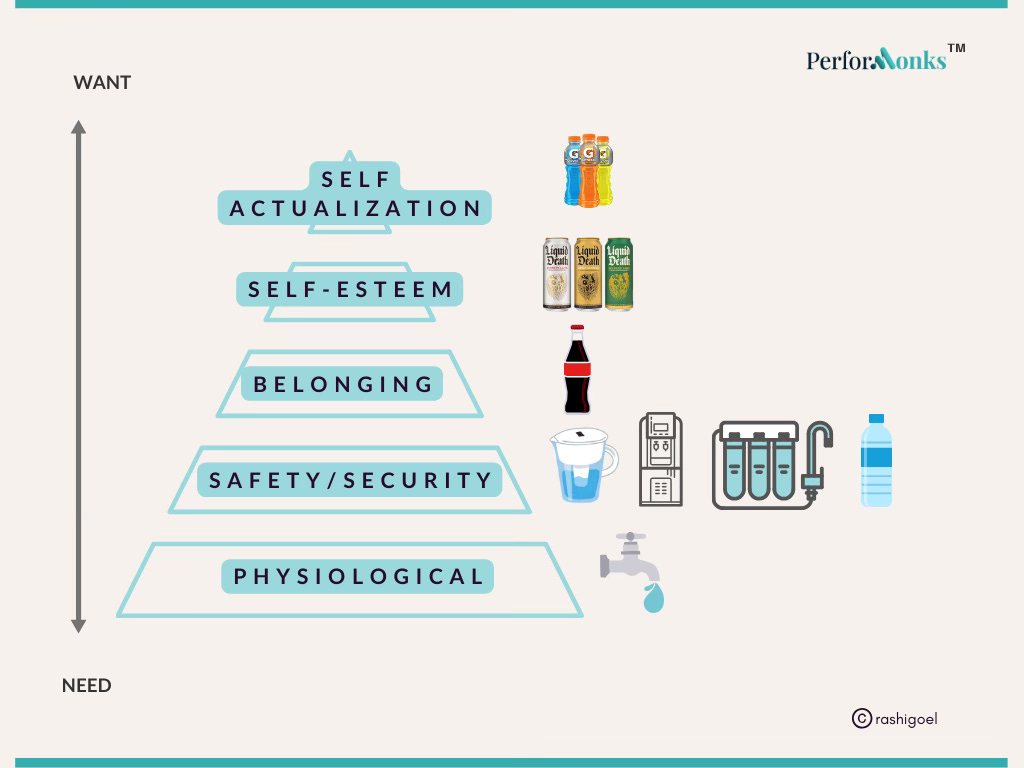
6. Break the ceiling – either through a new brand or through a portfolio
Does this mean a brand is stuck forever in the needstate it started with? Yes, I think so.
But there are two escape routes.
The first.
A strong brand can satisfy various needs through a portfolio of products. While Nike is positioned for self-actualization, products like the Nike Run Club App service the esteem (run time competitions) and belonging needs (belonging to your neighborhood running club) too.
The second. Buy brands.
SC Johnson’s portfolio is purely positioned at the lower-order needs of safety from a clean home.
On the other hand, Method was a cool new cleaning brand of sustainable products in pretty bottles designed by Ideo.
Instead of contorting its existing brands into shapes that would alienate consumers, SC Johnson added Method to its brand stable.
I will conclude this week’s edition by saying that “it depends” is the answer to most branding questions because branding, like life, is context- and taste-dependent.
Having sorting mechanisms in our heads helps. That’s the entire point behind the content I create.
I’ll see you next week.
